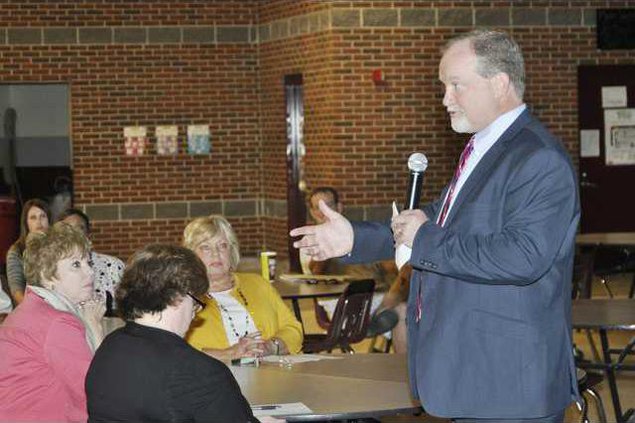Since the economic downturn in 2008, the Effingham County School System periodically has asked the state for waivers to the guidelines on how its money can be spent and how many students its classes can have.
However, to receive such waivers in the future, the state’s school districts are being required by the Georgia Department of Education to select one of three “flexibility options” for their governance. Effingham County Schools Superintendent Randy Shearouse outlined the three options at a pair of public informational sessions, attended by a total of about three dozen people.
“The state is seeing those (economic) numbers are starting to improve,” Shearouse said, “and therefore they’re not going to give you that flexibility unless you choose one of these options.”
Two of the options, called the charter system and the investing in educational excellence (IE2) system, allow school systems to continue to request waivers. The third option, called status quo, does not.
As an example of a waiver request, Shearouse told the audience the state might allot $80,000 for supplies for a school’s media center. However, school officials might decide the media center doesn’t need all that funding and $20,000 of it could be better spent elsewhere.
“So we could waive that requirement and spend $20,000 on something else we need in the school district,” Shearouse said.
The Effingham County Board of Education is “leaning toward” selecting the IE2 model, Shearouse said, since it most closely resembles the way the school system currently operates. IE2 allows districts to request waivers from Title 20 education regulations and have “flexibility to innovate” in their curriculum.
“In theory, it should give the board of education more local control,” Shearouse said, “because they have that much more flexibility – where Title 20 right now says you must do this, you must do that, you must spend the money here, you must spend the money there.”
Under IE2, the Governor’s Office of Student Achievement will set goals for school districts and monitor their performance, and recommend consequences for districts not meeting those targets. Shearouse pointed out the Effingham County School System already has similar accountability measures in place through its school improvement plans for each school and district-wide.
The charter system has many similarities to IE2, namely that it allows for waiver requests and possible financial savings from those waivers. Its main difference from IE2 is that the charter model gives school councils more authority to make decisions for the school they represent.
“They could decide, based on their budget, they may want to have one program and maybe do away with another program,” Shearouse said. “So they could make those decisions as a school council.”
The third option, status quo, does not allow for waiver requests, freedom from Title 20 guidelines and flexibility to innovate. Shearouse sees it as a possibility for only the state’s wealthiest school systems.
“There are some systems in Georgia that have a lot of money locally and they can operate without having any waivers in place,” he said.
Shearouse emphasized that none of the three flexibility options exempt school systems from complying with all state and federal laws. Districts will continue to abide by Common Core standards and Georgia Milestones assessments.
“A lot of folks say, ‘Can we do away with state testing?’ That’s not an option,” Shearouse said.
The Effingham County Board of Education must notify the state of its flexibility choice by June 30. The board could make a decision as soon as its April 16 meeting, Shearouse said.
Shearouse several times stressed the importance waivers played in the school district saving money during tough economic times. By increasing some class sizes, the district did not have to cut programs such as art and music.
“We didn’t want to do away with all those programs that mean so much to our students,” he said. “In my opinion, we could not have made it through that downturn had we not had waivers. We’re not a wealthy district at all, and if we don’t have the waivers, I’m not sure we’re going to be able to operate like we are currently.”





